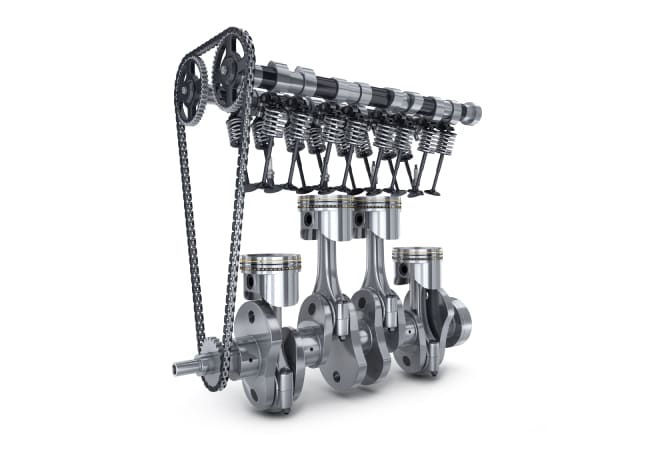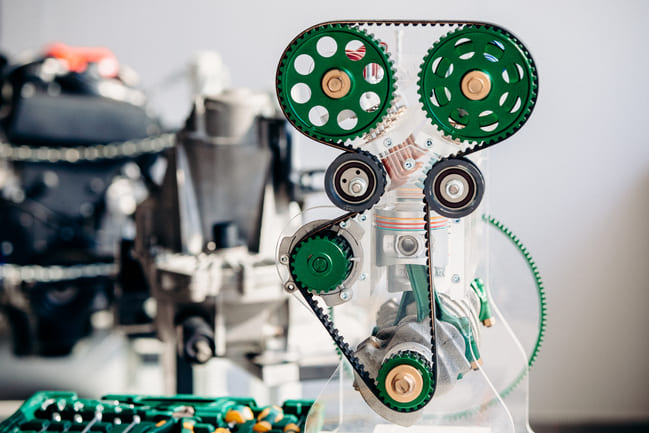
Contents
- 1 What is the purpose of the Components and how do they differ?
- 2 What indicates a defective toothed belt in the car?
- 3 How often does a timing chain have to be serviced and changed?
- 4 What are the effects of a broken timing chain?
- 5 How to recognize defects in the timing chain?
- 6 Does my car have a timing chain or a toothed belt?
- 7 TIMING CHAIN: In which Are they installed in vehicles?
- 8 Which is better: toothed belt or timing chain?
What is the purpose of the Components and how do they differ?
A car's internal combustion engine can be equipped with either a timing chain or a toothed belt. The former is usually made of steel, the latter of rubber. It is an essential component of engine control. Both have the same function: they connect the crankshaft to the camshafts, which ensure that the intake and exhaust valves open and close in a fixed cycle.
Nevertheless, the timing belt and timing chain differ in a few points .

A timing chain usually requires little maintenance become, but also costs more. Since, in contrast to the more vulnerable toothed belt, it does not have to be replaced as often or at all, this can pay off in the long run.

However, about 75% of modern cars are actually equipped with a toothed belt, because it makes the engine production cheaper and also causes less noise. However, as mentioned, it has to be replaced, and regularly. It moves constantly while the vehicle is in operation and is therefore heavily stressed. If it breaks, the consequences can be serious, since engine control is then no longer guaranteed and the pistons and valves can collide. In the worst case, the engine is totaled.
What indicates a defective toothed belt in the car?

- Visually inspect the component approximately every 20,000 miles to check for a cracked or frayed belt. It must not be worn out and the material must not be overstretched.
- Sometimes, however, appearances are deceptive and the material is brittle or porous without being visible to the naked eye. Therefore, pay attention to other, invisible signs such as reduced engine performance or grinding noises.
- The condition of the material can also deteriorate if it comes into contact with oil or water.
All this can also happen in cars that are not driven much, because the aging process affects the quality and wear of the timing belt as much as the mileage.
If you notice anything like this, it's time to change the timing belt. In order to avoid consequential damage and the associated high costs, do not put it off even if the defects are only minor. The replacement interval varies depending on the manufacturer, but is on average between 60,000 and 250,000 kilometers or between four and six years.
How often does a timing chain have to be serviced and changed?
Although timing chains are made of metal and are therefore many times more robust than toothed belts, this does not mean that a timing chain has a service life that is unlimited or independent of other factors or components in the vehicle. Errors can also occur during maintenance, care and daily use, which is why it must be checked and replaced if necessary.
There are no intervals specified by the manufacturer for this component. However, as a guide, the following general information can be used to ensure that the component is inspected in a timely manner:
- A single-row timing chain (simplex timing chain) is assumed to have a service life of around 100,000 – 200,000 kilometers before it needs to be checked.
- The more durable duplex chains (two rows of chains) can be used much longer: up to 500,000 kilometers.
Important: Make sure that the oil level is not too low, because caring for the engine components means that they are always sufficiently lubricated.
What are the effects of a broken timing chain?

The “worst case” is a broken chain. But even a stretched chain can have various serious consequences. Before a timing chain is installed by the manufacturer for the first time, the chain is pre-stretched, but it can still stretch under heavy use. This can result in
- the control times not being clocked correctly, which has a negative impact on the exhaust gas values and vehicle performance.
- Individual teeth on the control wheels are skipped , which can result in engine damage.
How to recognize defects in the timing chain?
Some defects in the timing chain are not immediately noticeable due to specific symptoms, but there are some indications that You should pay attention to:
- !Unusual noises such as rattling and rattling when the engine is started without first warming up: This indicates that the timing chain is stretching. What can be tricky is that these noises probably don't last longer than a few seconds. If you then hear these noises again the next time the engine starts cold, you should take the car to a workshop. When you take the car to a workshop for inspection, be sure to mention that you have heard such noises. Then the problem zone is examined with a corresponding diagnostic scanner, which compares the crankshaft and camshaft sensors and can thus determine chain elongation.
- ! Loud bang, engine no longer responds: possible timing chain tear. Pull over and have your vehicle towed to an auto repair shop.
- !Rattling and banging noises: speaks for defects in connection components such as the deflection roller. Stop driving the car and let professionals check it.
- ! Clacking noises combined with engine warning light: possible elongation of the timing chain. Don't put off visiting the workshop here either.

Take these warning signs seriously and take it to the workshop to avoid expensive consequential damage avoid. The timing chain therefore does not always have to be replaced straight away, readjusting the chain tensioner can be sufficient.
Does my car have a timing chain or a toothed belt?
This information should be noted in your vehicle handbook. Apart from that, you can also ask a mechanic at a workshop for maintenance or check it yourself. To do this, you have to remove the engine cover with the right tool, then you can easily see the difference: the timing chain is made of metal, the toothed belt is made of rubber.
TIMING CHAIN: In which Are they installed in vehicles?
Timing belts are still more common in passenger cars, but there is an increasing trend towards timing chains in cars.
Vehicles from the following brands or the specific models listed are B. either equipped with a control chain as standard or have this as an option:
- Many BMWs
- Mazda (with Skyactiv-G engine)
- Chevrolet Corvette
- Dacia Duster, Sandero, Sandero Stepway
- SAAB (with turbo engine)
- Many Mercedes
- Cadillac
- Alfa Romeo 159
- Honda Jazz
- Mazda (Skyactiv-G engine)
Which is better: toothed belt or timing chain?
Advantages and disadvantages of a timing chain
- < i class="as-icon as-icon--circle" style="background-color: #fffff">+ Long durability, can last for the entire life of the vehicle without replacement
- + Rare maintenance, check only at 100,000 – 200,000 km
- + The metal is resistant to temperature changes
- – High in price
- – Higher power consumption due to uneven rotation
- –Higher weight: increased fuel consumption and negative impact on engine performance.
Advantages and disadvantages of a toothed belt
- + Lower energy consumption
- + Low weight: lower fuel consumption no impairment of engine performance
- + Quiet operation
- + Inexpensive
- – May tear more easily
- – Must be checked frequently and regularly exchanged
- – The rubber is sensitive to fluctuating temperatures.
